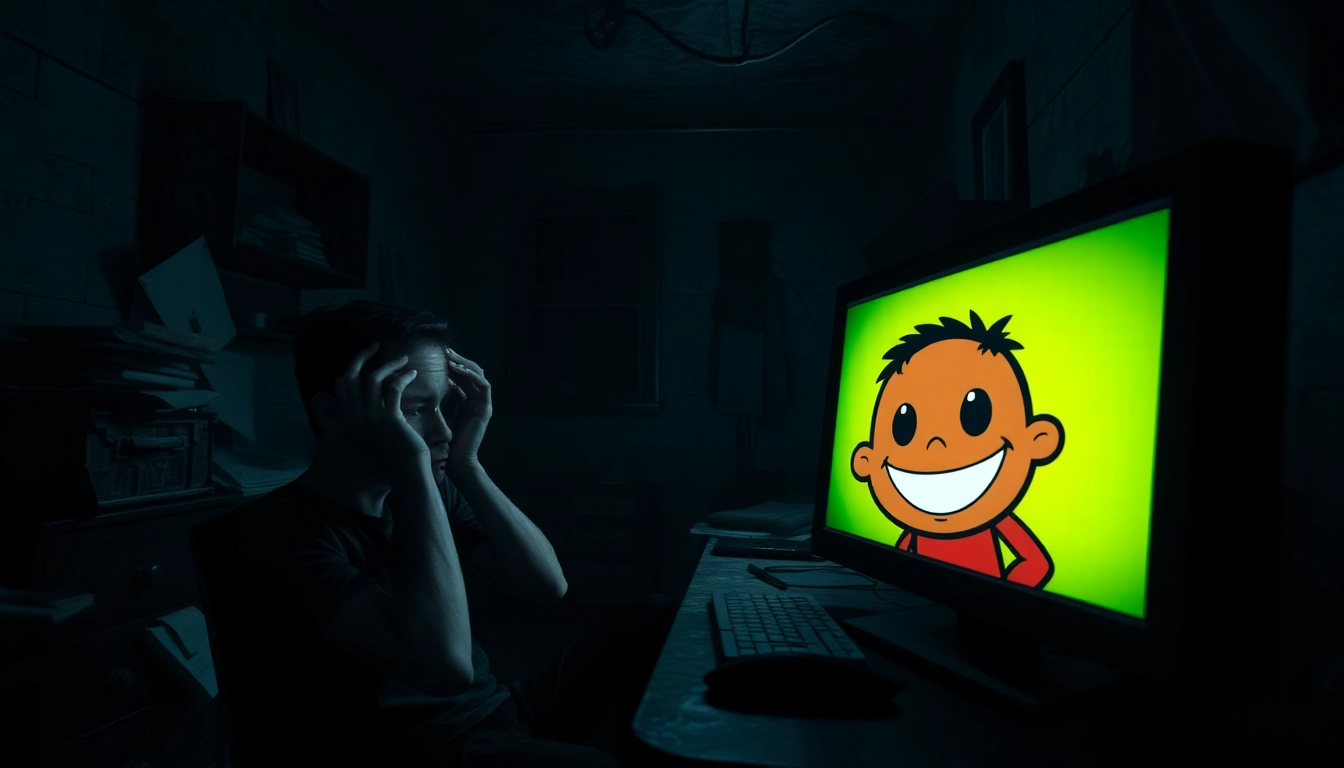Overview and Context of BLOODMONEY: DARK CLICKER DESCENT
In the realm of psychological horror games, few titles evoke the visceral discomfort and moral introspection as blood money. Designed as a dark clicker experience, BLOODMONEY plunges players into a disturbing world where each click not only increases their wealth but also deepens the moral decay of their character. This game isn’t just about earning; it’s about confronting the human capacity for cruelty and how far one is willing to go under desperate circumstances. Set against a bleak narrative backdrop, BLOODMONEY masterfully blends game mechanics with a visceral storytelling approach, creating an unsettling yet addictive experience.
Game Mechanics: The Core of BLOODMONEY
Clicking Mechanics and Profit Generation
The gameplay centers around a simple but intense mechanic: clicking on Harvey, a cheerful and seemingly innocent character, to generate money. Each click adds to your goal of raising $25,000 for urgent medical bills. The initial interaction appears innocuous, but as the game progresses, each click inflicts pain on Harvey, subtly shifting the tone. The more you click, the more money you earn, but Harvey’s reactions become increasingly distressed, visually and emotionally. This duality emphasizes the game’s core tension: survival versus morality.
Upgrade System and Escalating Violence
To maximize earnings, players can purchase upgrades from the in-game shop. These tools range from harmless objects like pillows to more violent instruments such as needles, scissors, and hammers. Each upgrade not only boosts profit but also amplifies Harvey’s suffering, creating a risk-reward dynamic that questions the player’s moral boundaries. The game cleverly offers a visual and emotional cue: Harvey’s appearance and dialogue reflect his pain, making the player acutely aware of their choices’ consequences.
The Dark Narrative of BloodMoney and Its Community Insights
The Psychological Horror and Time Pressure
BLOODMONEY immerses players in a nightmarish scenario where time is relentless, and moral choices have weighty repercussions. The ticking clock to gather $25,000 amplifies the tension, forcing players into a frantic state of decision-making. The psychological horror element intensifies as the visual cues become more disturbing and Harvey’s reactions more desperate. The game subtly explores themes of guilt, morality, and survival instinct, resonating deeply with players who appreciate dark narratives that challenge their ethics.
Multiple Pathways and Endings
One of BLOODMONEY’s compelling features is its multiple endings, determined by the player’s choices and upgrade paths. Players can aim for the “Good Ending” by minimizing Harvey’s suffering, opting for less violent tools like scissors. Alternatively, they may choose a “Normal Ending” with moderate violence, or fully embrace maximum efficiency regardless of human cost, culminating in the “Bad Ending.” These diverse outcomes serve as a mirror to the player’s moral compass, encouraging reflection on their decisions and their implications.
Gameplay Videos and Player Engagement
Community-driven gameplay videos reveal the depth and emotional impact of BLOODMONEY. Watchers observe how player choices influence Harvey’s visual deterioration and dialogue, offering insights into the game’s subtle storytelling techniques. Many players express discomfort and guilt, highlighting how the game effectively uses visual cues, sound design, and dialogue to evoke empathy and horror simultaneously. These videos serve as both entertainment and moral reflection, illustrating the game’s capacity to provoke strong emotional responses.
Clicking Mechanics and Visual Transformation
From Innocence to Horror
The core clicking mechanic is deceptively simple at first. Harvey appears cheerful, almost naive, encouraging players to click. However, each interaction leaves a visual mark—Harvey’s face contorts, and his body language shifts from cheerful to pained. Subtle visual cues, like tears or grimaces, become more prominent as the game progresses. This gradual transformation heightens the player’s discomfort and underscores the escalating moral cost of their actions.
Dialogue and Emotional Cues
Harvey’s dialogue becomes increasingly distressed, with subtle changes in tone that reflect his suffering. Observant players notice that Harvey seems unaware of the more violent tools, expecting harmless objects instead. For example, his surprise at a hammer indicates he may not fully understand what he’s being subjected to, adding a layer of moral ambiguity. These nuanced cues deepen the emotional impact, making players question their own choices and the nature of the “innocence” they are exploiting.
Upgrade System: The Path to Darkness
Tools and Their Consequences
The upgrade shop offers various tools designed to increase profit margins. Early upgrades, like needles, cause minimal harm but still impact Harvey’s well-being. As players progress, more violent options become available, such as scissors and hammers, which significantly boost earnings at the cost of Harvey’s physical and emotional suffering. The game’s design makes players confront the darker aspects of their actions: does the increased profit justify the pain inflicted?
Visual and Psychological Impact of Upgrades
Each tool’s visual representation and Harvey’s reactions reflect their brutality. The game uses these cues to evoke empathy and horror simultaneously. The more violent the tool, the more Harvey’s appearance deteriorates—his face becomes gaunt, eyes hollow, and his posture increasingly defeated. Dialogue also shifts, with Harvey expressing fear, confusion, or resignation, forcing players to reckon with the moral weight of their decisions.
Multiple Pathways and Endings: Moral Divergence
The Good Ending
Achieved by minimizing Harvey’s suffering, this ending emphasizes compassion and restraint. Players avoid the most violent tools, opting for the least damaging options like scissors or even no upgrades at all. In this path, Harvey retains some semblance of innocence, and the emotional toll remains manageable. The narrative reflects a moral stance that values human dignity over profit, culminating in a hopeful or redemptive conclusion.
The Normal Ending
This pathway involves moderate violence, using tools like scissors or needles. Harvey’s suffering is evident but not extreme, and the ending offers a balanced perspective—acknowledging the necessity of tough choices while recognizing their moral cost. It serves as a middle ground, illustrating the player’s compromise between survival and conscience.
The Bad Ending
Maximizing profit regardless of Harvey’s pain, often by using the most violent tools like hammers or knives, leads to this bleak conclusion. Harvey’s appearance is nearly unrecognizable, and his dialogue reflects despair and agony. This ending forces players to confront the horrifying reality of their choices, highlighting the destructive potential of moral indifference under pressure.
Psychological Analysis: Confronting Human Morality
BLOODMONEY is more than a dark clicker game; it’s a mirror reflecting the complexities of human morality when survival is at stake. The game employs subtle visual cues, dialogue, and narrative tension to examine how desperation can erode ethical boundaries. Harvey symbolizes innocence and hope, gradually consumed by the player’s actions, representing how fragile morality can be in extreme conditions.
Players often report feelings of guilt and emotional distress, which the game purposefully evokes through its design. The gradual transformation of Harvey and the escalation of violence serve as a powerful allegory for real-world dilemmas—how far are we willing to go for personal gain, and at what cost? The game challenges players to reflect on the thin line separating right from wrong, especially when their own survival hangs in the balance.
Community Insights and Player Reactions
Players worldwide share their experiences and moral reflections through forums and gameplay videos. Many discuss how the game made them feel uncomfortable yet compelled to continue, highlighting its emotional depth. Some players express surprise that they could achieve the “Good Ending” even with tools like the hammer, revealing the game’s subtle tracking of moral choices. Others admit to feeling guilt or shame after realizing how their actions affected Harvey, emphasizing the game’s success in fostering moral introspection.
The Game’s Narrative and Emotional Design
BloodMoney’s narrative is a masterclass in emotional storytelling within a minimalist gameplay framework. The visual design, dialogue, and soundscape work in harmony to build an increasingly disturbing atmosphere. Harvey’s changing expressions and reactions serve as a constant reminder of the moral stakes, making each click a moral decision rather than mere gameplay. This synthesis of mechanics and storytelling creates a compelling, thought-provoking experience that lingers long after the game ends.
Final Reflections: Boundaries of Morality and the Dark Allure of Survival
Ultimately, BLOODMONEY challenges players to confront their own moral boundaries. It questions whether survival justifies the means and explores the psychological toll of such choices. Is the desire to save oneself worth the moral cost? The game doesn’t provide easy answers but instead invites reflection through its intense emotional design and multiple endings. It masterfully demonstrates that in the darkest situations, human nature is tested—are we inherently good, or do circumstances reveal our true selves?
As you navigate the disturbing journey of BLOODMONEY, remember that each click is a moral act, and every choice shapes the outcome. The game’s power lies in its ability to evoke empathy, guilt, and introspection, making it a profound exploration of morality under pressure. The dark allure of survival might tempt some to cross moral boundaries, but it also offers a stark reminder of the cost of such decisions.
About BLOODMONEY and Related Games
BloodMoney stands out as a unique psychological horror experience that combines minimalist gameplay with profound moral questions. Its success has inspired discussions about morality in gaming, and it remains a compelling example of how narrative and emotional design can elevate simple mechanics into a deeply impactful experience. Fans of dark, thought-provoking titles will find BLOODMONEY to be a haunting journey that lingers in the mind.
Connect With Us
If you found this exploration insightful and want to stay updated on similar psychological horror experiences, follow our community and stay tuned for future content. Your thoughts and reflections are always welcome—share your journey, discuss your endings, or suggest other titles that challenge morality and perception. Join us as we delve into the darker facets of gaming, where every click is a moral choice and every story a reflection of human nature.
Remember, the world of blood money is not just a game—it’s a mirror held up to our own moral boundaries. How far are you willing to go when survival depends on your choices?





